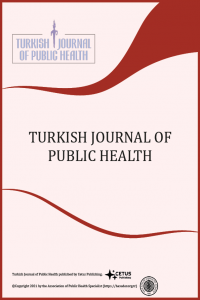Seroprevalance of rickettsioses among healthy individuals in Mersin province, Turkey
Seroprevalance of rickettsioses among healthy individuals in Mersin province, Turkey
Objective: Studies relevant to rikettsial biology, its pathogenesis and diagnosis have increase due to the increase of rickettsioses incidents in the world, particularly over the the past two decades. We investigated the seroprevalence of the ricketsia disease in the Mersin province of Turkey. Methods: This study included 450 healthy individuals aged 5 years and over, who had attended family health centers in Mersin city center. Serum samples collected during November 2011 were evaluated. Rickettsia antibody assays were used indirect immunofluorescenc techniques. Data were analyzed using a descriptive analysis, the Chi-Square Test and the Student T Test for comparison of variables. Results: The prevelance of ricketsia positivity was determined as 9.8%. The seropositivities were higher in males, in the unemployed, in the occupational risk groups, in people who live in rural regions, in people who work in gardens/farms, in picnickers, in countryside walkers, in hunters, in owners of livestock, in people with no history of rash diseases. When the relationship of spotted fever group (SFG) seropositivity the risk factors was investigated, there was no statistical significance. Conclusion: According to our study rickettsial disease is detected in Mersin and it was seen that the rickettsiosis disease need for more comprehensive studies to show the prevalence in all of Turkey.
Keywords:
Rickettsioses, seroprevelance,
___
- 1. Mandell GL, Bennett JE, Dolin R. In: Principles and Practise of Infestious disease 7th ed. USA: Introduction of rickettsioses, 2010;186:2495-2498.
- 2. Portillo A, Santibáñez S, García-Álvarez L, Palomar AM, Oteo JA. Rickettsioses in Europe Microbes and Infection 2015;17: 834-838.
- 3. Parola P, Paddock CD, Raoult D. Tick-Borne rickettsioses around the world: Emerging diseases challenging old concepts. Clin Microbiol Rev 2005;18: 719-756.
- 4. Topçu AW, Söyletir D. Riketsiya ve Erlihliya Enfeksiyonları In: Enfeksiyon Hastalıkları ve Mikrobiyolojisi: 3. baskı, İstanbul: 2008;150:1979-1990.
- 5. Scola La B, Raoult D. Laboratory diagnosis of rickettsioses: Current approaches to diagnosis of old and new rickettsial diseases J Clin Microbiol 1997; 35:2715-2727.
- 6. Eren N, Hamzaoğlu O. Türkiye’de Bulaşıcı Hastalıklar (1925-1993). Ankara: Türk Tabipleri Birliği, 1996:80-81.
- 7. Mert A, Tabak F, Dumankar A, Eroğlu C, Öztürk R, Aktuğu Y. Dört Marsilya humması olgusu. Klimik Derg 1997;10: 146-148.
- 8. Kuloğlu F, Rolain JM, Akata F. First Isolation of Rickettsia Conorii From Humans in the Trakya Region of Turkey. Eur J Clin microbiology Infect disease 2004;23:609-614.
- 9. Aydin L, Bakirci S. Geographical Distribution of Ticks in Turkey. Parasitol Res 2007;101 (Suppl 2):163-166.
- 10. Vural T, Ergin C, Sayin F. Investigation of Rickettsia conorii antibodies in the Antalya area. Infection 1998;26:170-172.
- 11. Tekin A, Gözalan A, Çöplü N, Yılmaz G, Köksal İ. Türkiye’nin Karadeniz Bölgesinden seçilmiş merkezlerde Riketsiya seropozitivitesi ve risk faktörleri; Dicle Tıp Derg 2015;37(3): 204-210.
- 12. Marshall GS, Stout GG, Jacobs RF, et al. Antibodies Reactive to Rickettsia Rickettsii Among Children Living in the Southeast and South Central Regions of the United States. Arch Pediatr Adolesc Med 2003;157: 443-448.
- 13. Kuloğlu F, Filiz A,Tansel Ö, Gürcan Ş. Son Altı Yılda Trakya Bölgesindeki Benekli Ateş Grubu Riketsiyoz Olgularının Özellikleri; Klimik Dergisi 2004; (17)2: 87-90.
- 14. Özgüneş N, Ergen P, Yazıcı S, Aksoy Y, Bekler G, Sargın F.; Yirmi Riketsiyoz Vakası. Klimik Derg 200114: 91-92.
- 15. Gençer S, Özer S, Ak Ö. Riketsiyozlu 19 hastanın değerlendirilmesi. XII. Türk Klinik Mikrobiyoloji ve Enfeksiyon Hastalıkları Kongresi Bildiri Özet Kitabı 2005, ss: 253.
- 16. Vural T, Ergin Ç, Kurşun AE. Antalya Yöresinde Rickettsia Conorii Antikorlarının Araştırılması. Mikrobiyol Bült 1995; 29:370-374.
- Başlangıç: 2003
- Yayıncı: Halk Sağlığı Uzmanları Derneği
Sayıdaki Diğer Makaleler
Hafize Özdemir Alkanat, Edip Özer, Sevil Özdemir, Mehmet Alkanat
Babalola TESLEEM K., Okafor IFEOMA P
Hatay'da Akraba Evliliği'ne Dönük Eleştirilere Yanıt
Kayıhan PALA, Rukiye ÇAKIR, Murat CİVANER
Seroprevalance of rickettsioses among healthy individuals in Mersin province, Turkey
İlker ALAKUŞ, Elif ŞAHİN HORASAN, Ahmet Öner KURT, Güliz EVİK, Gülden ERSÖZ, Gönül ASLAN, Ali KAYA
